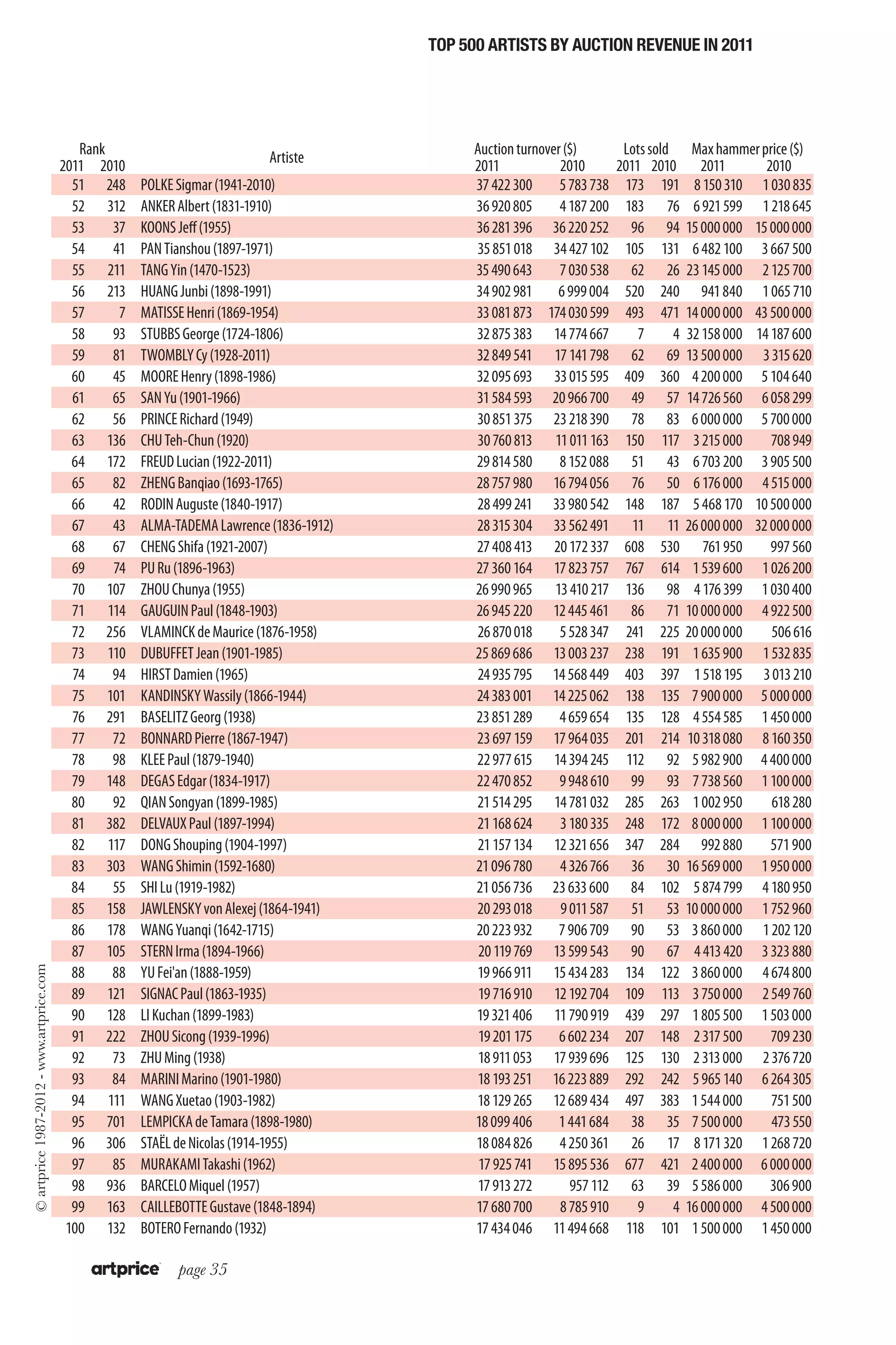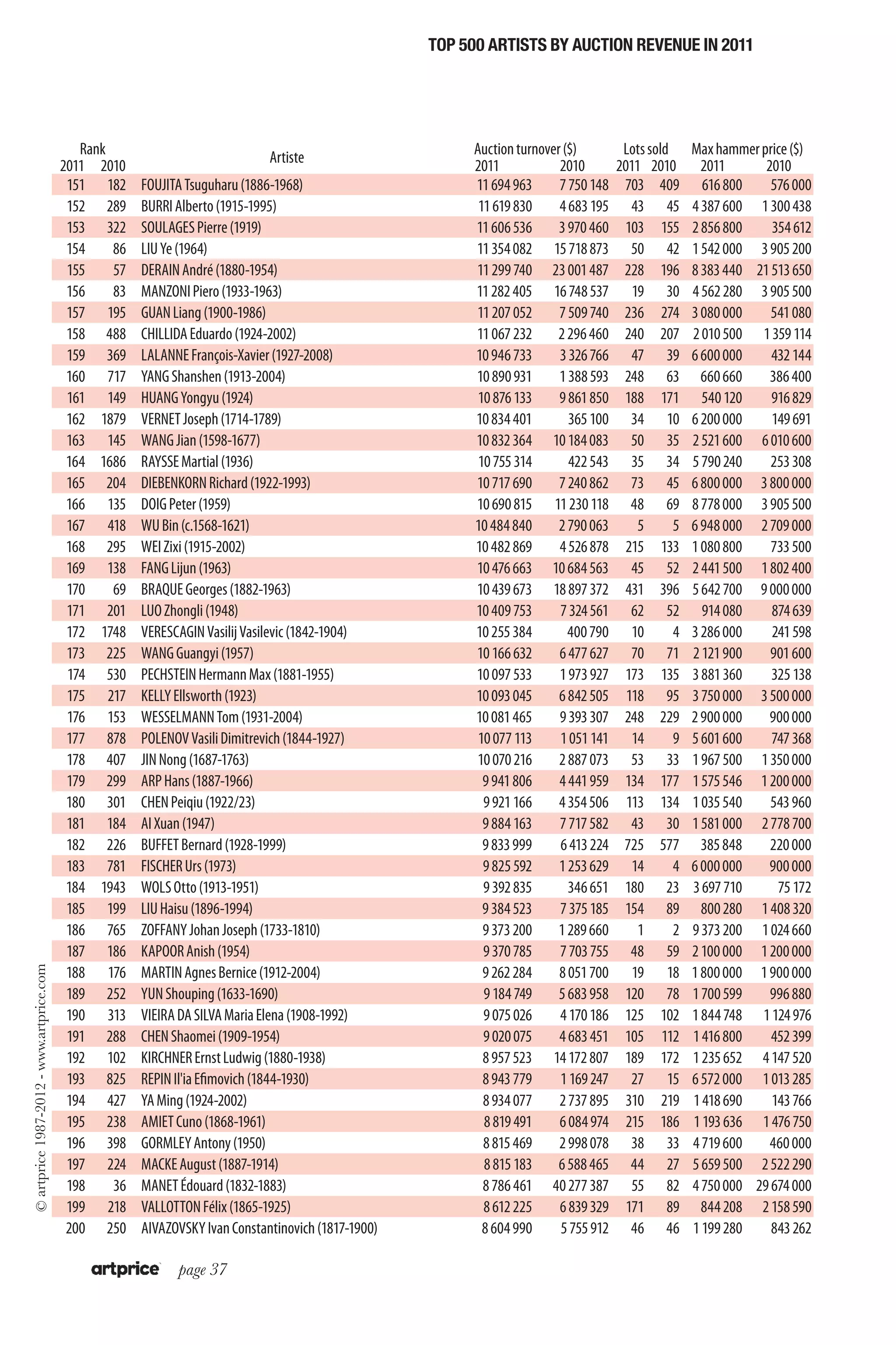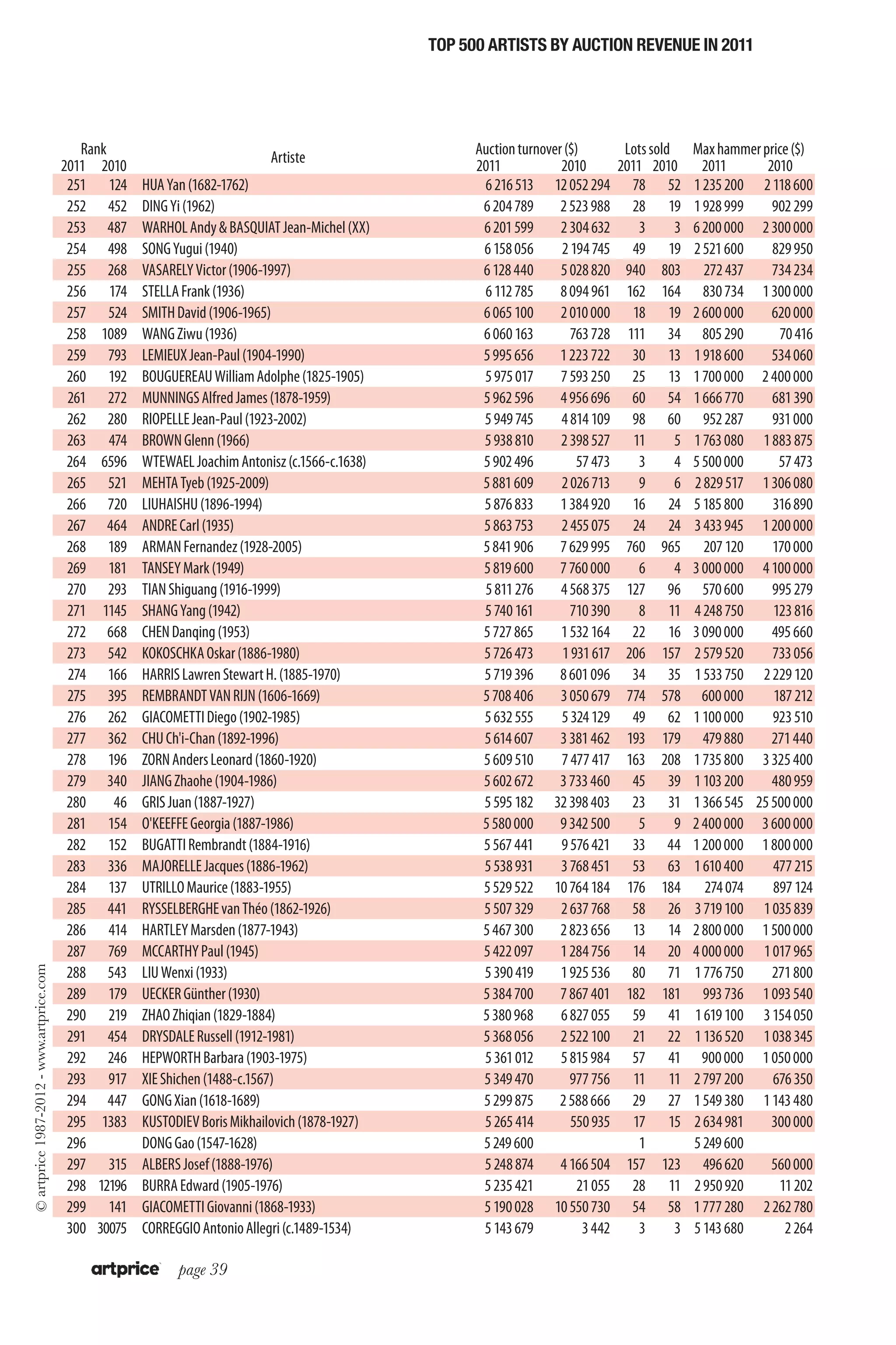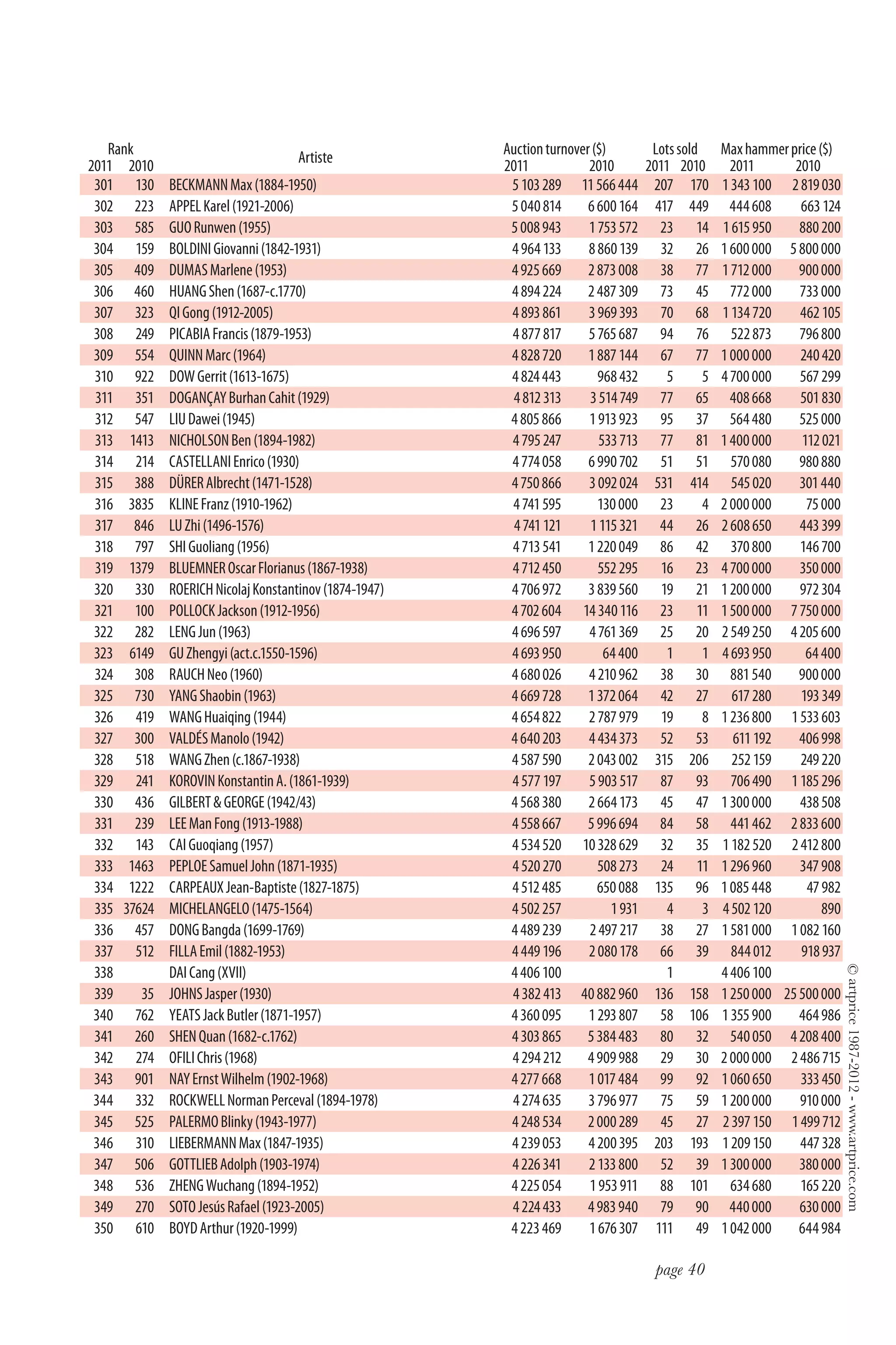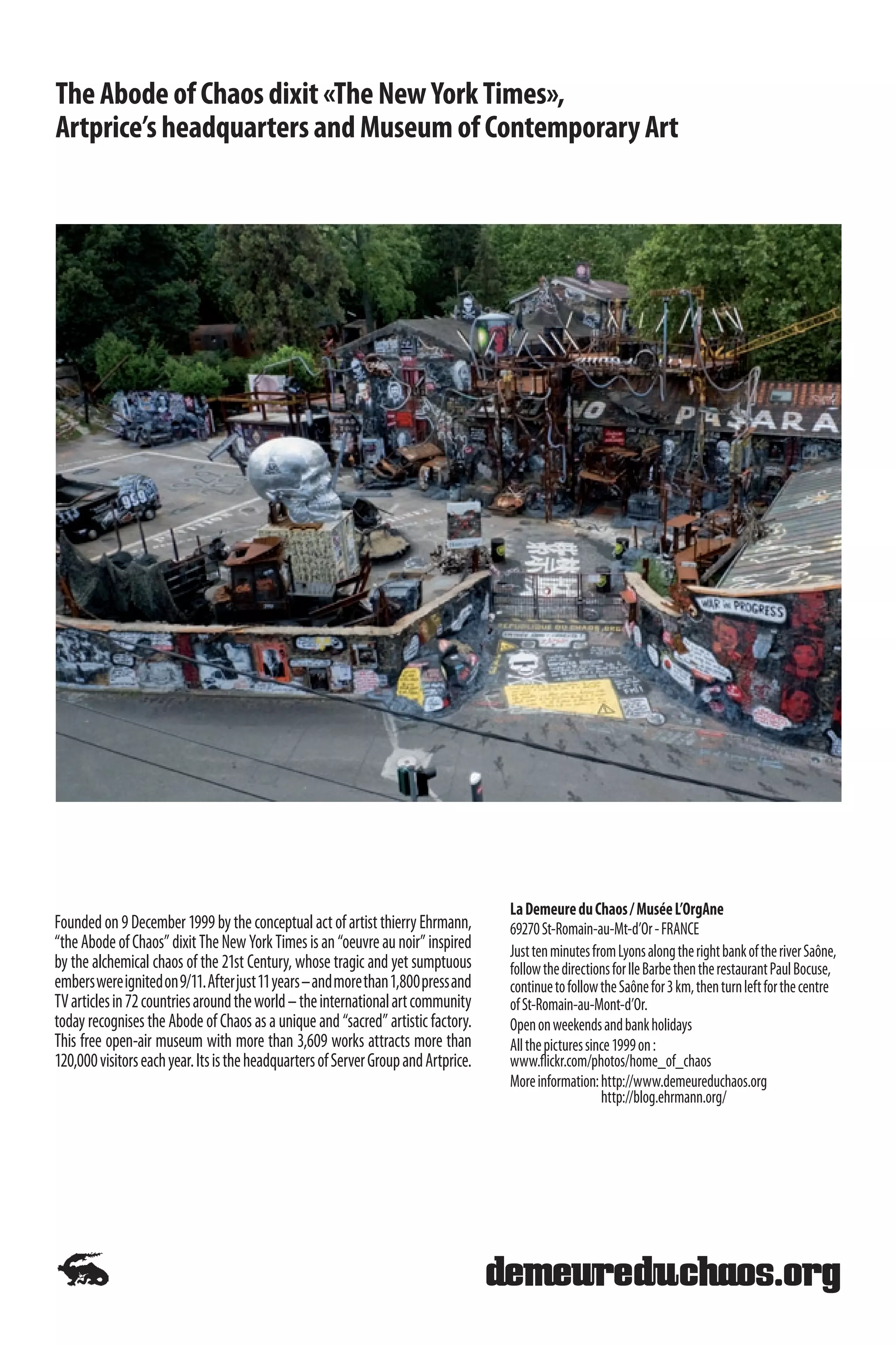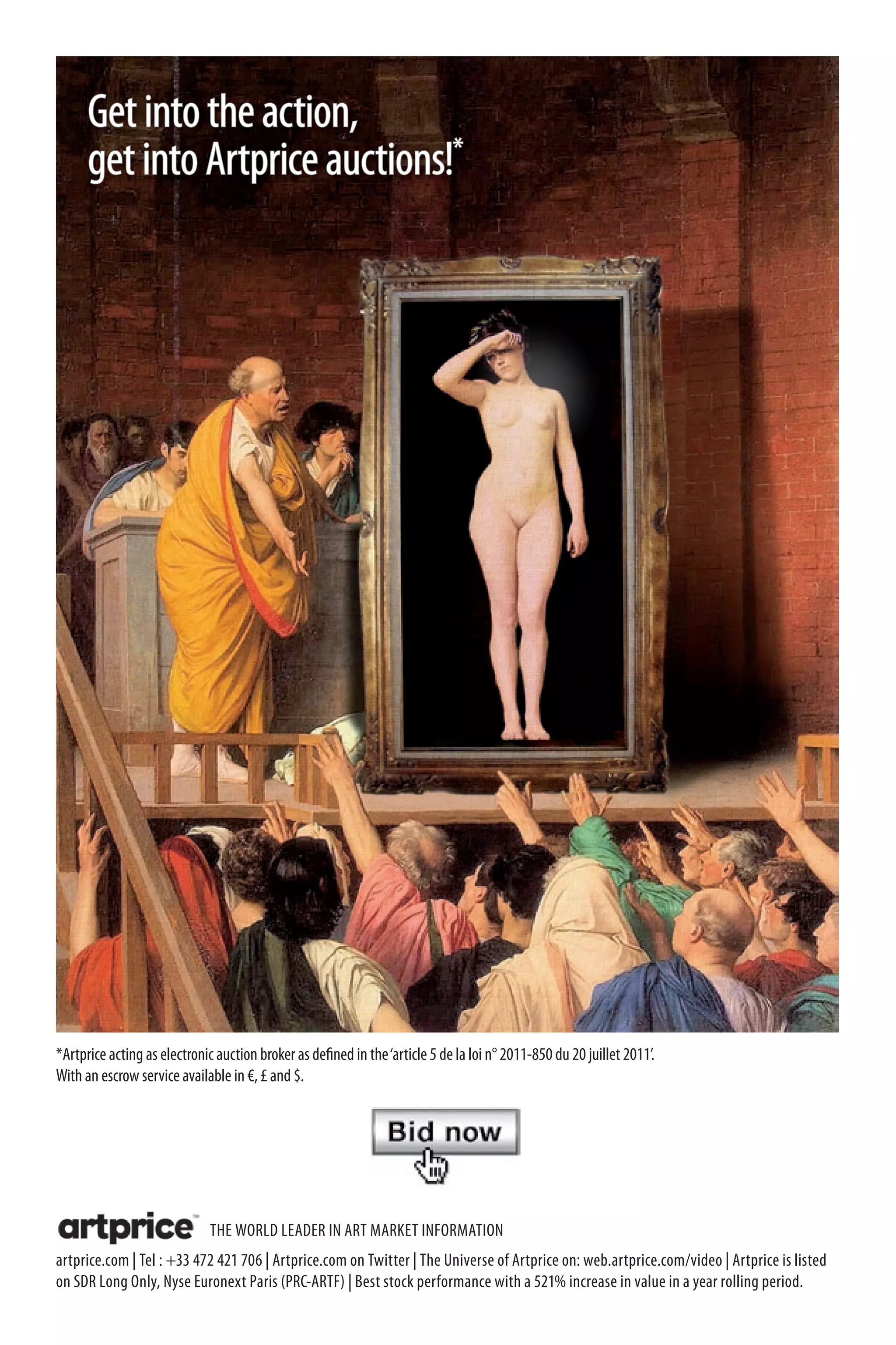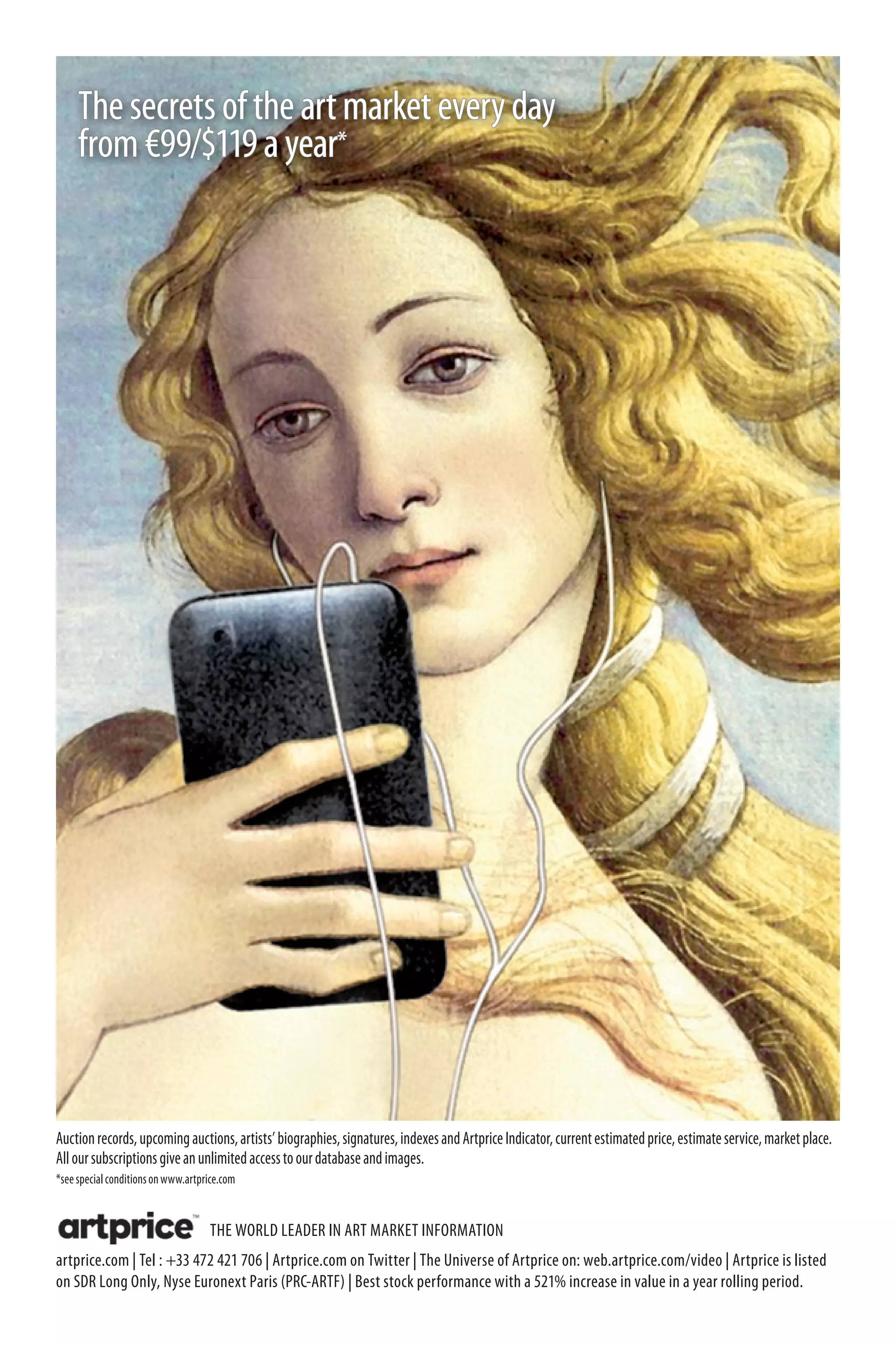The document analyzes the 2011 art market. Some of the key points covered include:
- China surpassed the US and UK to become the largest art auction market in the world, driven by growth in Beijing and Hong Kong.
- Overall auction sales revenue grew 21% from 2010, with gains across all mediums and segments including modern, postwar, contemporary, and old masters.
- Asia experienced the strongest growth led by China, with other Asian countries like Singapore and Indonesia also posting large increases.
- The high-end art market above $1 million was unaffected by the economic crisis, with China generating the most auction results above this level.





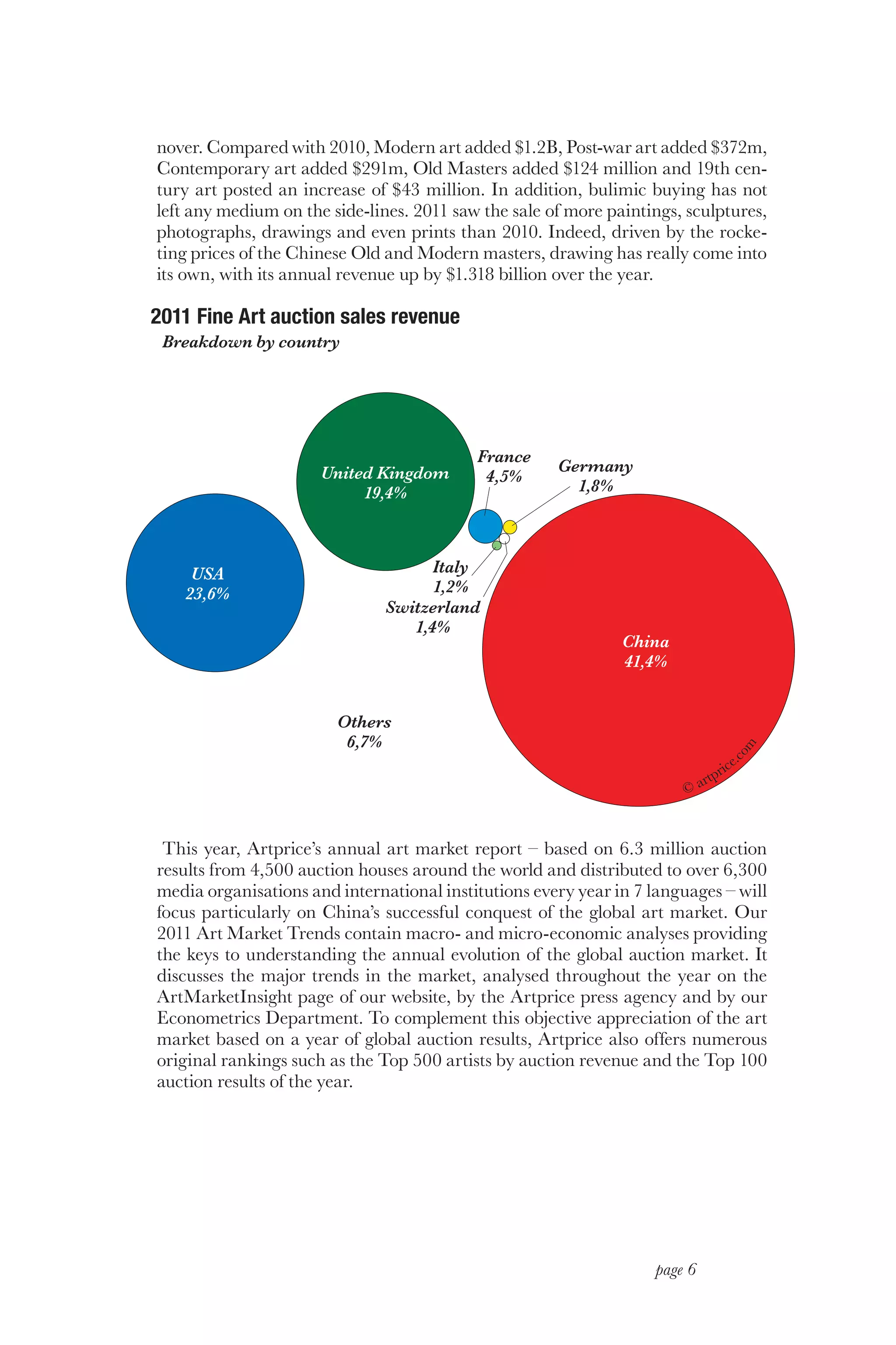
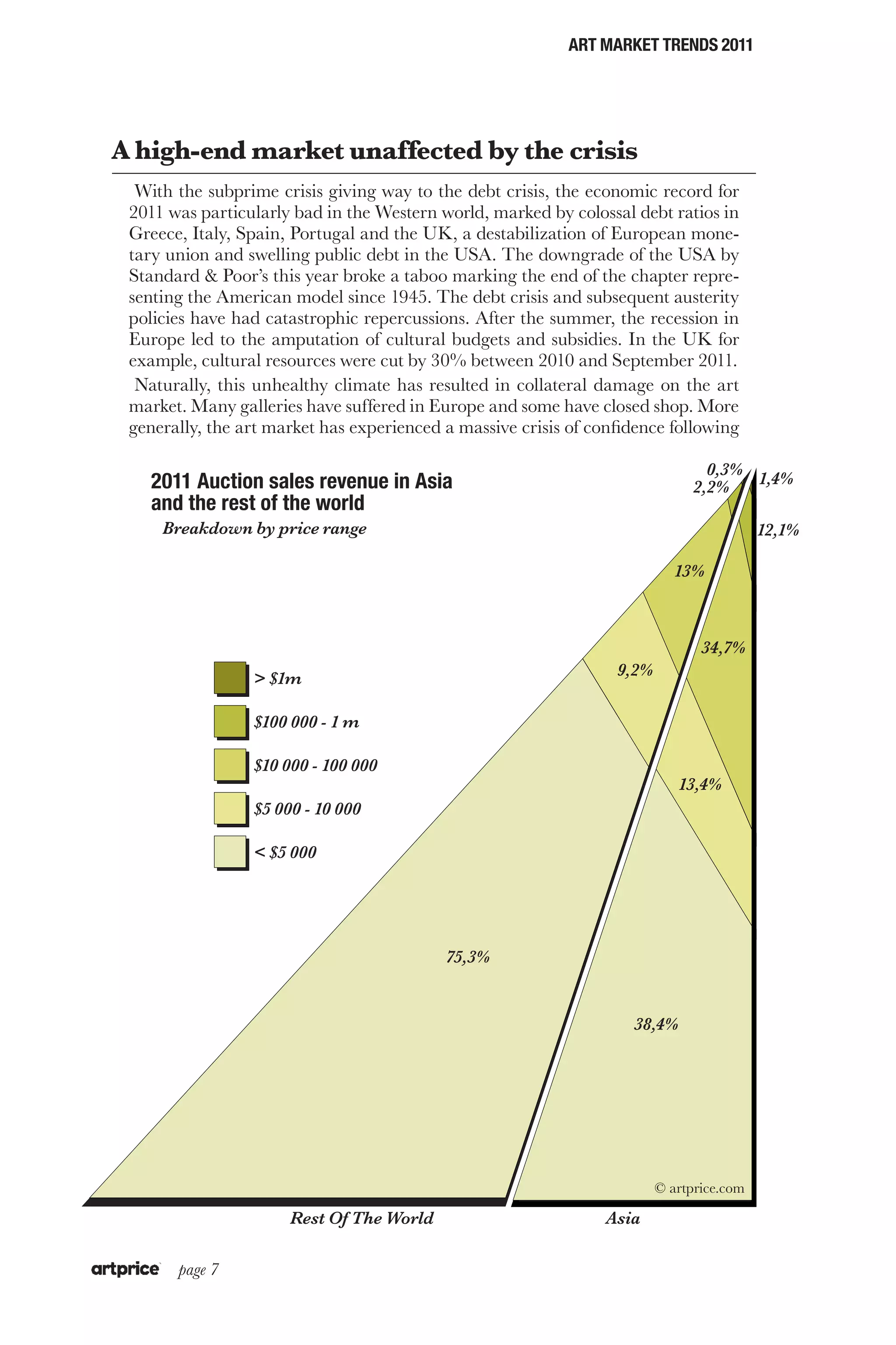
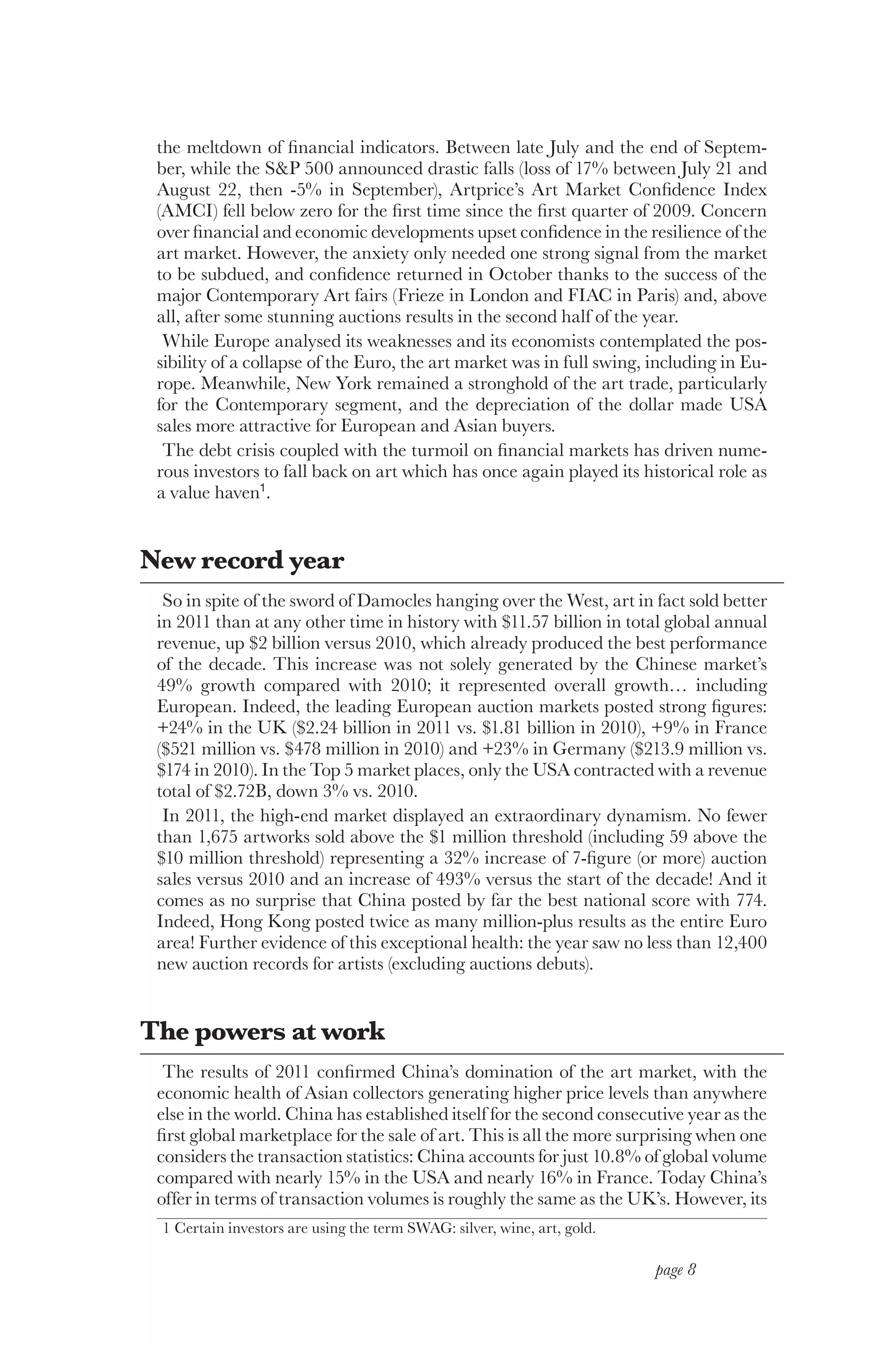






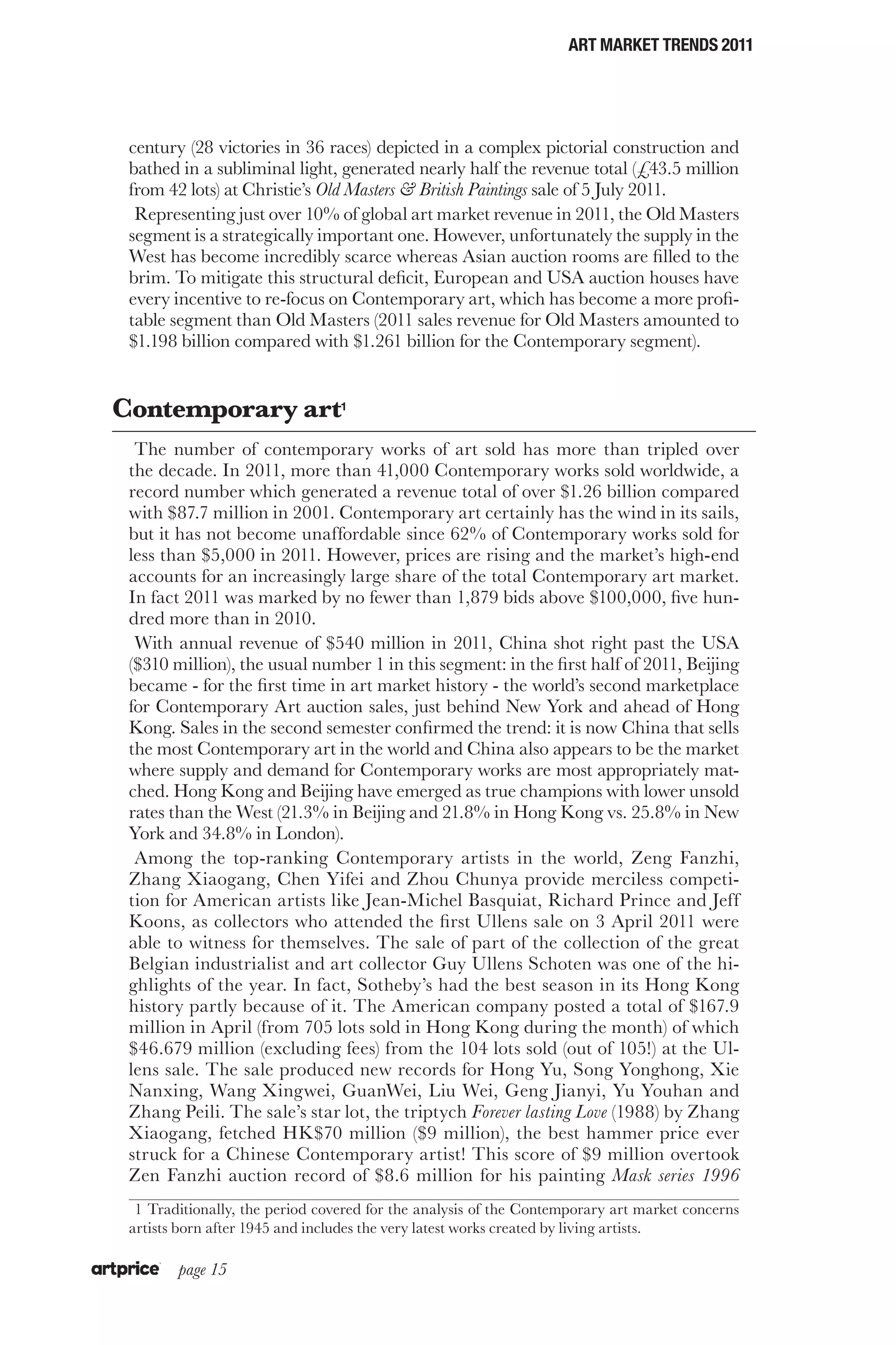


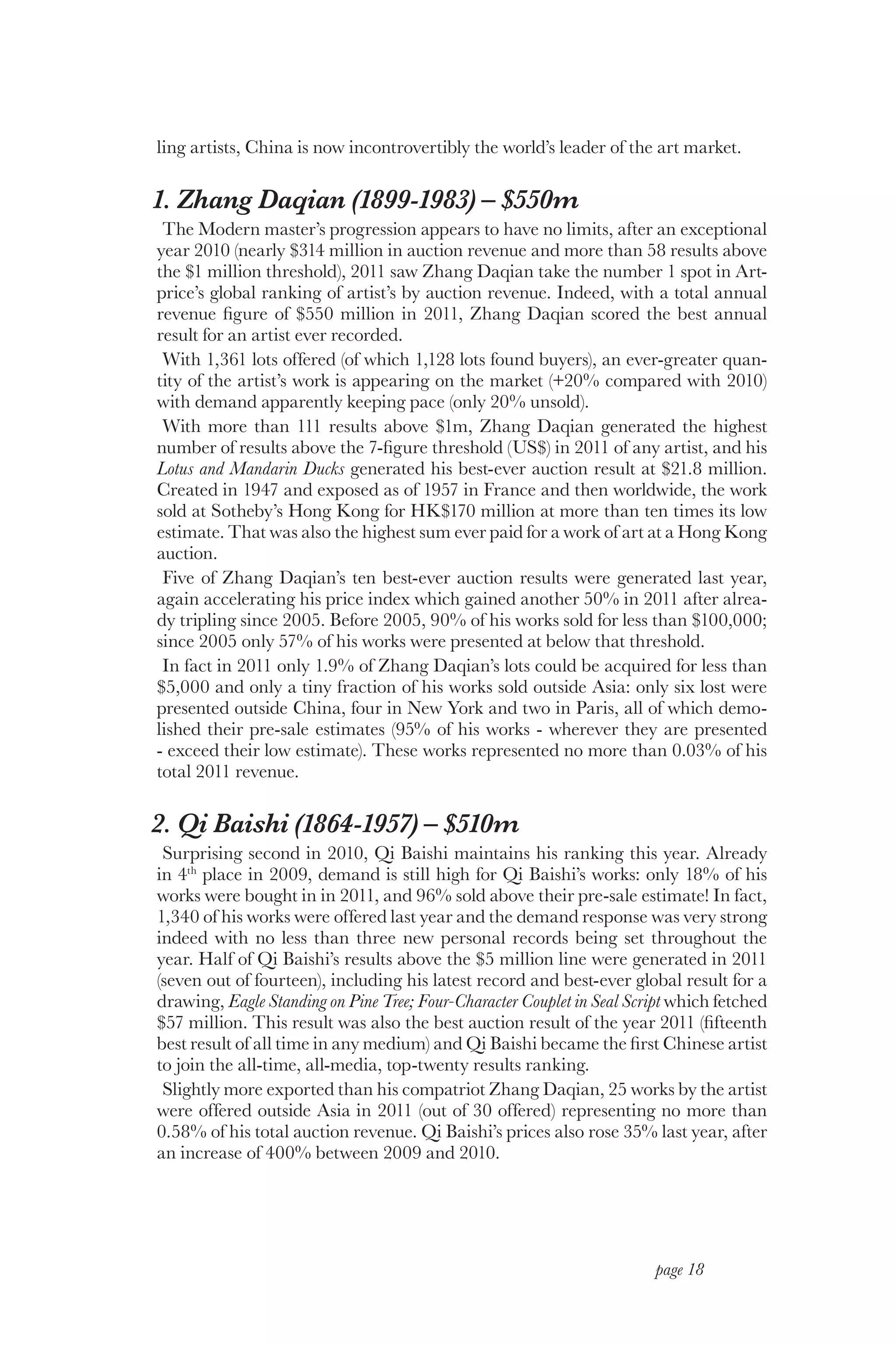
![ART MARKET TRENDS 2011
3. Andy Warhol (1928-1987) – $325m
The only Western artist remaining in the top 3, Andy Warhol generated a slightly
better total than his 2010 auction revenue ($313 million). Amounting to $325m,
the American Pop artist’s total gives him third place in the global ranking for
2011, and, for the second time only, he overtook Pablo Picasso. Warhol’s 2011
figures strangely resemble his 2010 figures with a similar annual total (+4%), 46
results above the $1 million line (vs. 40 in 2010), a 26% unsold rate (vs. 29% in
2010) and a volume of lots sold just 1% up from the previous year. The only real
difference was the absence of a record result in the top 5 (after his Men In Her Life
fetched $56.5 million in 2010, the year’s fourth best result). In 2011, his best result
was generated by a Self-Portrait that fetched $34.25 million against a pre-sale es-
timate of $20 million – $30 million. This was in fact the year’s tenth best global
result.
Still very much in demand in the West (75% of his revenue came from the USA in
2011 and 23% from Europe [o/w 21% from the UK]), Warhol does not yet trigger
frenzied bidding at Asian sales and in 2011 only 0.2% of his annual revenue was
generated in Asia from 13 lots (i.e. less than 1% of his total auction lots offered
worldwide). The relative slowness to acquire new tastes of the American market,
where 37% of Andy Warhol’s works are sold, is maintaining the artist’s price index
(+12% in 2011).
4. Pablo Picasso (1881-1973) – $315m
Fourth place in 2011 for Pablo Picasso, whose worst performance since 1989 had
been third place in 1992 and who has won thirteen of the fourteen first places
since 1997. Worse still, he was not even the most sought-after Western artist in the
2011 ranking (beaten by Andy Warhol, as in 1997) and he was the only artist in the
Top 10 whose annual auction revenue did not rise, but actually fell 13%!
However, it wasn’t actually a bad year for Picasso. His $315 million revenue total
was larger than the combined totals of the top 3 artists in 2009 and it was $45
million better than the number 1 artist in 2008 who was none other than Pablo
Picasso himself.
The relative fall in demand for Picasso’s work in 2011 was essentially due to lower
high-end demand for his work. In 2011, only thirty-nine of his works fetched over
$1m, his lowest million-plus score since 2005 (excluding 2009). Moreover, only six-
teen of the twenty-nine lots offered above the $1 million line in New York actually
sold! In 2010, two of the year’s seven best auction results were signed by Picasso.
In 2011, his best result came seventh.
Although Picasso is still the most frequently sold artist at auction sales with more
than 2,500 lots in 2011, he nevertheless suffered an unsold rate of 29%, close to
the catastrophic levels of 2009 (33% remained unsold) and far from the 15 - 20%
unsold rates between 2004 and 2007.
In 2010, Pablo Picasso dominated the art market: best result of the year… new
world record… highest annual revenue… price index up 17%... unsold rate of
21%... That is why his ejection from the Top-3 podium in 2011 is so startling.
page 19](https://image.slidesharecdn.com/arttrend2011-120304035453-phpapp02/75/Art-trend-2011-19-2048.jpg)


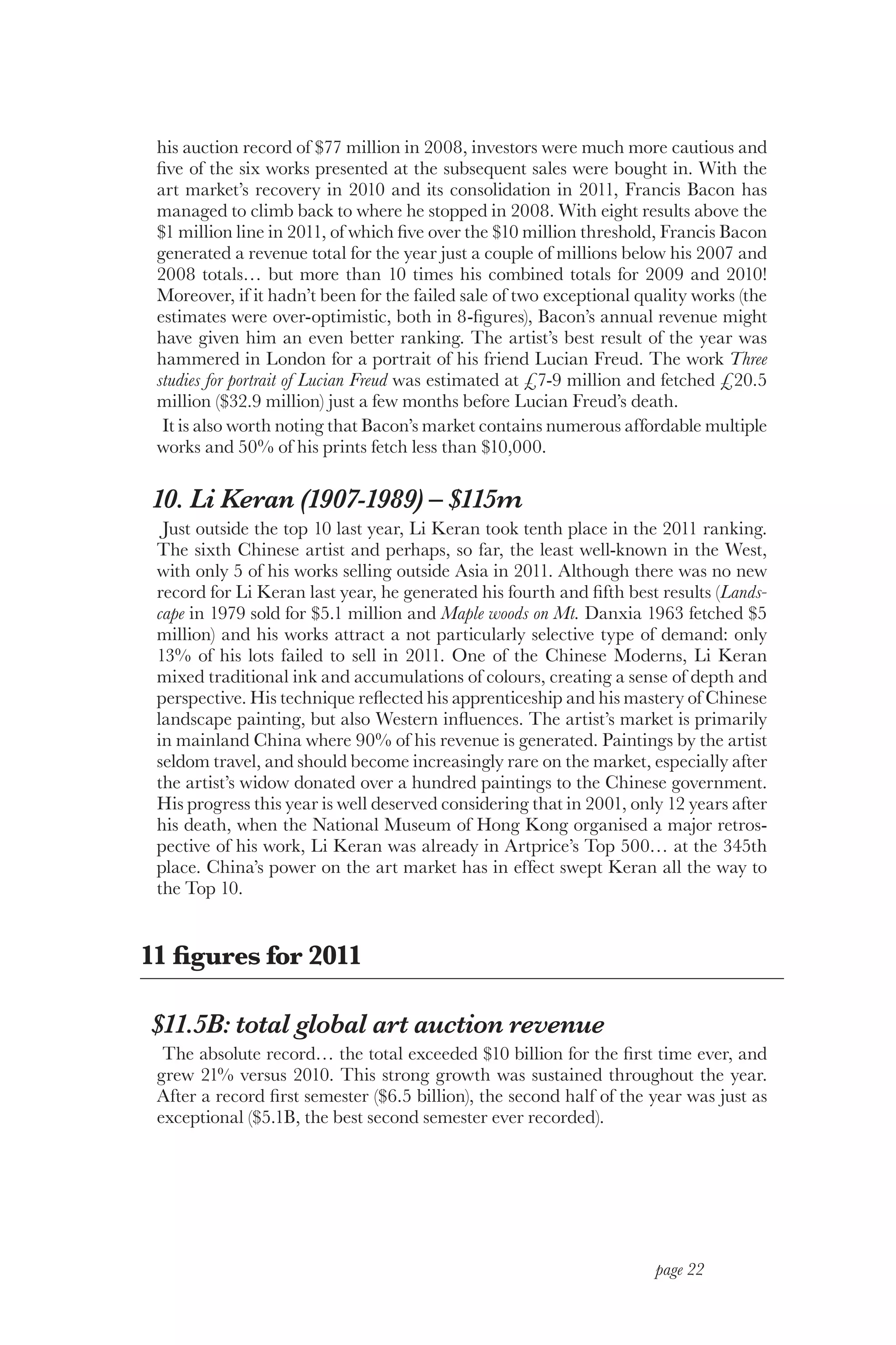

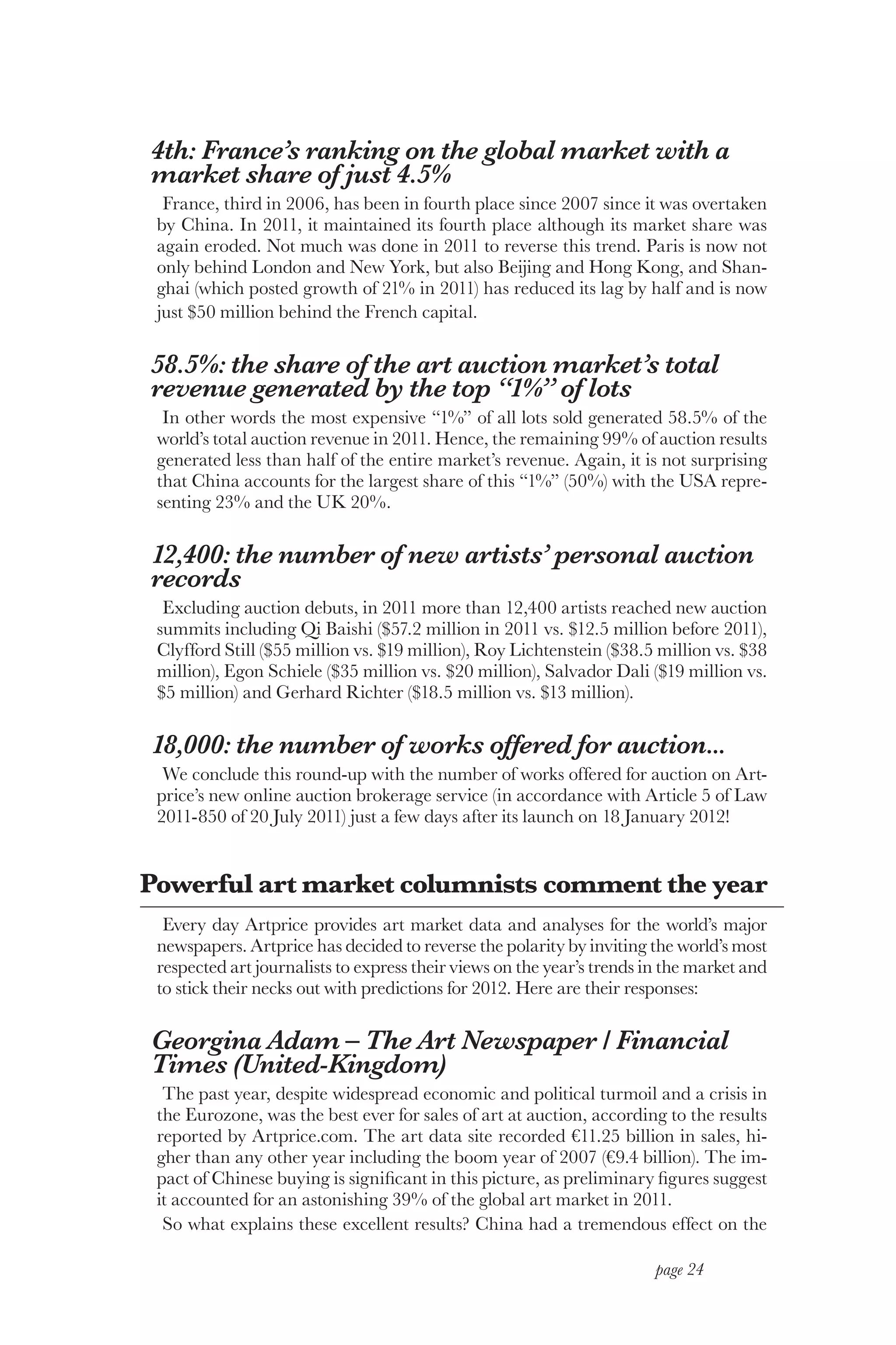


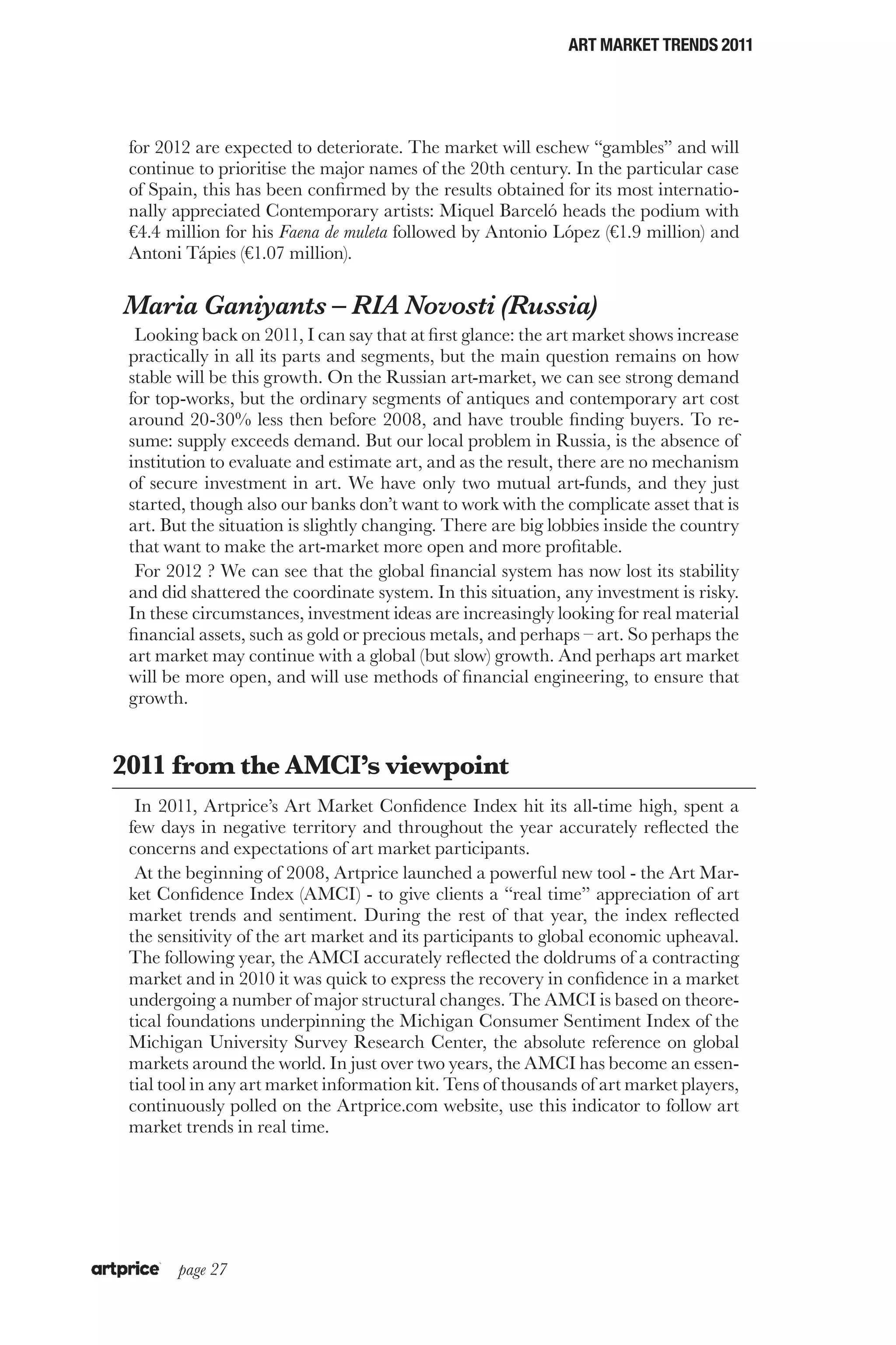
![ong)
ong K
Fair (H
arrel)
Art Market Confidence Index by Artprice.com
2011 AMCI Barometer
ng Art
,75 $ ( b
4,41
64
45
ID) : 5
ng Ko
00 : 13
oil 126
by’s (B
ay Ho
. S&P5
40
Crude
Sothe
m
7,5
29 apr
26-29
35
8 apr.
dex : 7
5 apr.
on)
(Lond
nce In
30
63,7
don)
7 m$)
(NY)
an
(NY)
odern
ndex:
onfide
in Jap
rt (Lon
25
odern
i QI (5
don)
t-War
ndon)
ence I
ist & M
HK
ters C
m
r (Lon
rary A
st & M
Baish
& Pos
r. Seis
’s
20
rn (Lo
otheby
Confid
n Reu
ession
st-Wa
tempo
g […]
ssioni
orary
11 ma
Mode
15
tion S
ichiga
euters
y & Po
. Impr
tandin
Impre
ntemp
b. Con
onist &
Collec
1 feb. M
gan R
10
8/9 feb
porar
agle S
15/16 fe
ay Co
3 may
Ullens
Michi
pressi
ontem
011: E
5
10/11 m
une Im
1 may
3 apr.
cord 2
june C
0 ay Re
21/22 j
28-29
-5
22-24 m
01/04
01/03
01/02
01/01
01/06
01/05
A first semester full of confidence
The first half of 2011 saw lots of new records. With total global Fine Art auction
revenue of more than $6.3 billion between 1 January and 30 June, the first half
of 2011 was the most dynamic six- month period in art market history. Moreover,
during the same period, art prices climbed 17% to above the 2007/2008 levels.
It was therefore normal that during H1 2011, the AMCI only once fell below
the 20 confidence points level. With hindsight, this 20 point level – reflecting a
strong level of art market demand as well as a considerable degree of optimism – is
the threshold above which our respondents are effectively expecting art prices to
continue rising more or less uninterruptedly.
The only time it moved below the 20 point level was between 15 and 20 March
which was exactly when Artprice announced that China had become the world’s
leading Fine Art marketplace. As Artprice CEO Thierry Ehrmann said at the
time, the news had the effect of an “electroshock” on the art market, and the
AMCI dropped 10 points. Several days after the impact of the news, confidence
returned and the AMCI settled definitively above 30 confidence points throu-
ghout the month of April.
The exceptional sales revenue figures from sales in New York, Hong Kong and
page 28](https://image.slidesharecdn.com/arttrend2011-120304035453-phpapp02/75/Art-trend-2011-28-2048.jpg)



![Artist Hammer price Artwork Sale
1 QI Baishi $57 202 000 Eagle Standing on Pine Tree; Four-Character [...] 22 may (China Guardian BEIJING)
2 STILL Clyfford E. $55 000 000 "1949-A-No . 1" (1949) 09 nov. (Sotheby's NY)
3 WANG Meng $54 040 000 Zhi Chuan moving to Mountain 04 june (Poly International BEIJING)
4 LICHTENSTEIN Roy $38 500 000 "I Can See the Whole Room!...and [...]" (1961) 08 nov. (Christie's NY)
5 GUARDI Francesco $38 256 120 Venice, a View of the Rialto Bridge, Looking [...] 06 jul. (Sotheby's LONDON)
6 XU Beihong $36 679 200 Cultivation on the peaceful land (1951) 05 dec. (Poly International BEIJING)
7 PICASSO Pablo $36 274 500 La lecture (1932) 08 feb. (Sotheby's LONDON)
8 KLIMT Gustav $36 000 000 Litzlberg Am Attersee (c.1914/15) 02 nov. (Sotheby's NY)
9 SCHIELE Egon $35 681 800 Häuser mit bunter wäsche (Vordatdt II) [...](1914) 22 june (Sotheby's LONDON)
10 WARHOL Andy $34 250 000 Self-Portrait (1963-1964) 11 may (Christie's NY)
11 BACON Francis $32 957 850 Three studies for portrait of Lucian Freud 10 feb. (Sotheby's LONDON)
12 STUBBS George $32 158 000 Gimcrack on Newmarket Heath, with a trainer [...] 05 jul. (Christie's LONDON)
13 FU Baoshi $31 520 000 Landscapes (1964/65) 17 nov. (Beijing Hanhai Art BEIJING)
14 ROTHKO Mark $30 000 000 Untitled No. 17 (1961) 11 may (Christie's NY)
15 STILL Clyfford E. $28 000 000 1947-Y-No. 2 (1947) 09 nov. (Sotheby's NY)
16 QI Baishi $26 786 500 Landscape (1931) 13 nov. (China Guardian BEIJING)
17 ALMA-TADEMA Lawrence $26 000 000 The Meeting of Antony and Cleopatra: 41 Bc 05 may (Sotheby's NY)
18 PICASSO Pablo $25 872 000 Femme assise, robe bleue (1939) 21 june (Christie's LONDON)
19 BACON Francis $25 536 000 Study for a portrait (1953) 28 june (Christie's LONDON)
20 WARHOL Andy $24 500 000 Self-Portrait (1986) 11 may (Christie's NY)
21 WARHOL Andy $24 000 000 Liz #5 (Early Colored Liz) (1963) 12 may (Phillips de Pury & Co NY)
22 TANG Yin $23 145 000 Landscape 09 june (Beijing Jiuge International)
23 REN Yi $22 533 000 Huafeng People’s Wishes to Emperor Yao 16 jul. (Xiling Yinshe Auction HANGZHOU)
24 BACON Francis $22 500 000 Studies for Self-Portrait (1974) 11 may (Christie's NY)
25 ZHANG Daqian $21 845 000 "Lotus and Mandarin Ducks" (1947) 31 may (Sotheby's HK)
26 XU Beihong $20 596 270 Figure 10 june (Beijing Jiuge International)
27 PICASSO Pablo $20 500 000 L'aubade (1967) 02 nov. (Sotheby's NY)
28 MONET Claude $20 000 000 Les Peupliers (1891) 04 may (Christie's NY)
29 VLAMINCK de Maurice $20 000 000 Paysage de banlieue (1905) 04 may (Christie's NY)
30 PICASSO Pablo $19 404 000 Jeune fille endormie (1935) 21 june (Christie's LONDON)
31 DALI Salvador $19 292 400 Portrait de Paul Eluard (1929) 10 feb. (Sotheby's LONDON)
32 PICASSO Pablo $19 000 000 Femmes lisant (deux personnages) (1934) 03 may (Sotheby's NY)
33 PICASSO Pablo $19 000 000 Les femmes d'Alger, version L (1955) 04 may (Christie's NY)
34 RICHTER Gerhard $18 500 000 Abstraktes Bild (1997) 09 nov. (Sotheby's NY)
35 SHI Tao $18 355 700 landscape 01 jan. (Nanjing Jingdian BEIJING)
36 WARHOL Andy $18 000 000 Sixteen Jackies (1964) 10 may (Sotheby's NY)
37 BACON Francis $17 500 000 "Three Studies for a Self-Portrait" (1967) 09 nov. (Sotheby's NY)
38 STILL Clyfford E. $17 500 000 Ph-1033 (1976) 09 nov. (Sotheby's NY)
© artprice 1987-2012 - www.artprice.com
39 WANG Hui $17 435 000 Landscape inspired by tang poems (1710) 13 nov. (China Guardian BEIJING)
40 WANG Shimin $16 569 000 landscapes (1647) 05 nov. (Sungari International BEIJING)
41 ROTHKO Mark $16 500 000 White Cloud (1956) 08 nov. (Christie's NY)
42 CAILLEBOTTE Gustave $16 000 000 Le pont d'Argenteuil et la Seine (c.1883) 02 nov. (Sotheby's NY)
43 RICHTER Gerhard $16 000 000 "Gudrun" (1987) 09 nov. (Sotheby's NY)
44 WARHOL Andy $15 440 640 Self-Portrait (1967) 16 feb. (Christie's LONDON)
45 WU Guanzhong $15 440 000 Lion Woods (1988) 03 june (Poly International BEIJING)
46 GIACOMETTI Alberto $15 408 050 Trois hommes qui marchent II (1948) 22 june (Sotheby's LONDON)
47 PICASSO Pablo $15 361 500 Buste de Françoise (1946) 21 june (Christie's LONDON)
48 KOONS Jeff $15 000 000 Pink panther (1988) 10 may (Sotheby's NY)
49 TIZIANO VECELLIO $15 000 000 A Sacra Conversazione: the Madonna and Child [...] 27 jan. (Sotheby's NY)
50 SAN Yu $14 726 560 Five Nudes (1950') 30 may (Ravenel Art Group HK)
page 32](https://image.slidesharecdn.com/arttrend2011-120304035453-phpapp02/75/Art-trend-2011-32-2048.jpg)
![Top 100 auctions performances in 2011
Artist Hammer price Artwork Sale
51 SU Shi $14 677 500 bamboo and stone 16 june (Beijing Highest BEIJING)
52 RICHTER Gerhard $14 630 760 Kerze (Candle) (1982) 14 oct. (Christie's LONDON)
53 ERNST Max $14 500 000 The Stolen Mirror (1941) 01 nov. (Christie's NY)
54 WARHOL Andy $14 500 000 Silver Liz (1963) 08 nov. (Christie's NY)
55 CUI Ruzhuo $14 113 000 "Lotus" (2011) 29 nov. (Christie's HK)
56 MATISSE Henri $14 000 000 La fenêtre ouverte (1911) 04 may (Christie's NY)
57 WU Hufan $13 553 600 Landscape (1954) 17 nov. (Beijing Hanhai Art BEIJING)
58 TWOMBLY Cy $13 500 000 Unititled (1967) 11 may (Christie's NY)
59 BRANCUSI Constantin $13 200 000 Le premier cri (1917) 01 nov. (Christie's NY)
60 HONG Yi $13 115 500 Figure (1939) 09 june (Beijing Jiuge International)
61 QI Baishi $12 765 600 Banana trees 17 nov. (Beijing Hanhai Art BEIJING)
62 RICHTER Gerhard $12 500 000 Abstraktes Bild (1992) 09 nov. (Sotheby's NY)
63 QI Baishi $12 368 000 Flowers and birds 22 may (China Guardian BEIJING)
64 BACON Francis $11 825 940 Crouching Nude (1961) 29 june (Sotheby's LONDON)
65 FU Baoshi $11 412 000 Song of a pipa player 13 nov. (China Guardian BEIJING)
66 CHEN Yifei $10 934 000 Wind of Mountain Village (1994) 24 may (China Guardian BEIJING)
67 BONNARD Pierre $10 318 080 Terrasse à Vernon (1923) 09 feb. (Christie's LONDON)
68 RICHTER Gerhard $10 257 920 Abstraktes Bild (1990) 15 feb. (Sotheby's LONDON)
69 WU Guanzhong $10 244 000 Former residence of Qiu Jin (2002) 03 dec. (Poly International BEIJING)
70 ZHU Da $10 055 500 Lotus (1699) 21 june (Beijing Chieftown BEIJING)
71 GAUGUIN Paul $10 000 000 Jeune tahitienne (c.1893) 03 may (Sotheby's NY)
72 JAWLENSKY von Alexej $10 000 000 Frau mit grünem fächer (1912) 03 may (Sotheby's NY)
73 WARHOL Andy $9 895 200 Mao (1973) 28 june (Christie's LONDON)
74 BRUEGHEL Pieter II $9 517 830 The Battle between Carnival and Lent 06 dec. (Christie's LONDON)
75 BOURGEOIS Louise $9 500 000 Spider (1996) 08 nov. (Christie's NY)
76 ZHANG Daqian $9 412 300 Flowers (1944) 09 june (Beijing Jiuge International)
77 PICASSO Pablo $9 407 020 Couple, le baiser (1969) 22 june (Sotheby's LONDON)
78 ZOFFANY Johan Joseph $9 373 200 The Garden at Hampton House, with Mr and Mrs [...] 07 dec. (Sotheby's LONDON)
79 GAINSBOROUGH Thomas $9 325 820 Portrait of Mrs. William Villebois, full-length [...] 05 jul. (Christie's LONDON)
80 FAN Zeng $9 258 000 Figure (1997) 09 june (Beijing Jiuge International)
81 GAUGUIN Paul $9 216 900 Le vallon (1892) 21 june (Christie's LONDON)
82 SHI Tao $9 169 800 Arhat 05 dec. (Poly International BEIJING)
83 ZHANG Xiaogang $9 002 000 Forever Lasting Love 03 april (Sotheby's HK)
84 MAGRITTE René $9 000 000 Les vacances de Hegel (1958) 01 nov. (Christie's NY)
85 DOIG Peter $8 778 000 "Red boat (Imaginary boys)" (2003/04) 28 june (Christie's LONDON)
86 WARHOL Andy $8 700 000 Four Campbell's Soup Cans (1962) 08 nov. (Christie's NY)
87 QI Baishi $8 695 500 Landscape 20 nov. (Beijing Highest BEIJING)
88 BACON Francis $8 500 000 Untitled (Crouching Nude on Rail) (1952) 11 may (Christie's NY)
© artprice 1987-2012 - www.artprice.com
89 PICASSO Pablo $8 500 000 Couple à la guitare (1970) 03 may (Sotheby's NY)
90 WU Guanzhong $8 492 000 Shrubalthea (1975) 03 june (Poly International BEIJING)
91 ZHANG Daqian $8 481 000 "Children Playing under a Pomegranate Tree" (1948) 31 may (Sotheby's HK)
92 DERAIN André $8 383 440 Bateaux à Collioure (1905) 09 feb. (Christie's LONDON)
93 QI Baishi $8 337 600 Grass and insects 03 june (Poly International BEIJING)
94 MITCHELL Joan $8 250 000 Untitled (c.1960) 09 nov. (Sotheby's NY)
95 MONET Claude $8 200 000 Antibes, Le Fort (1888) 02 nov. (Sotheby's NY)
96 VELDE van de Willem II $8 191 575 Dutch men-o'-war and other shipping in a calm 06 dec. (Christie's LONDON)
97 STAËL de Nicolas $8 171 320 Nu couché, (Nu) (1953/54) 06 dec. (Artcurial (S.V.V.) PARIS)
98 POLKE Sigmar $8 150 310 Dschungel (Jungle) (1967) 29 june (Sotheby's LONDON)
99 HUANG Zhou $8 116 499 Horse training (1976) 22 may (China Guardian BEIJING)
100 TOULOUSE-LAUTREC de Henri $8 109 499 La liseuse (1889) 22 june (Sotheby's LONDON)
page 33](https://image.slidesharecdn.com/arttrend2011-120304035453-phpapp02/75/Art-trend-2011-33-2048.jpg)

